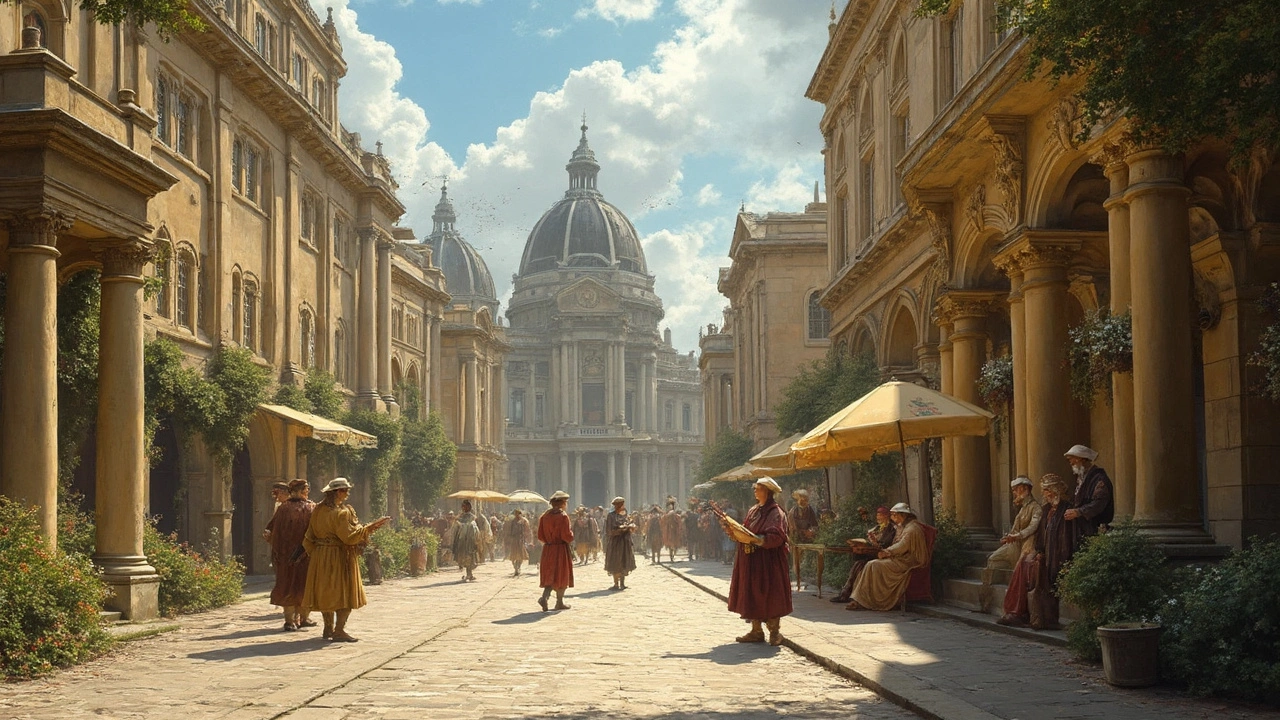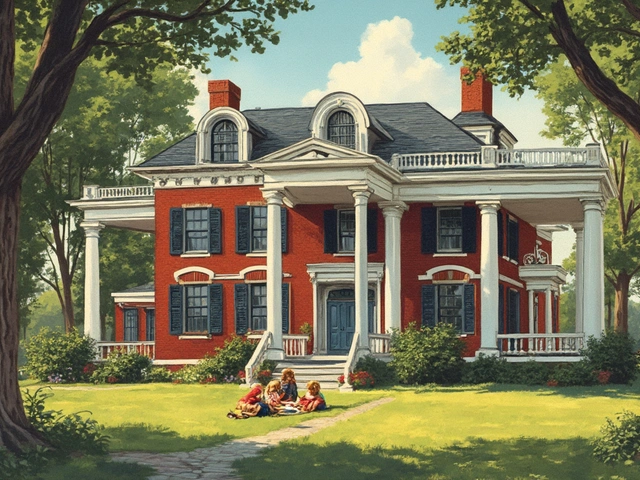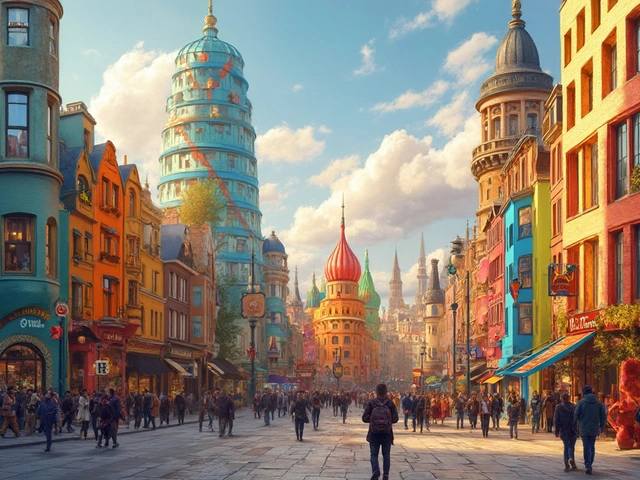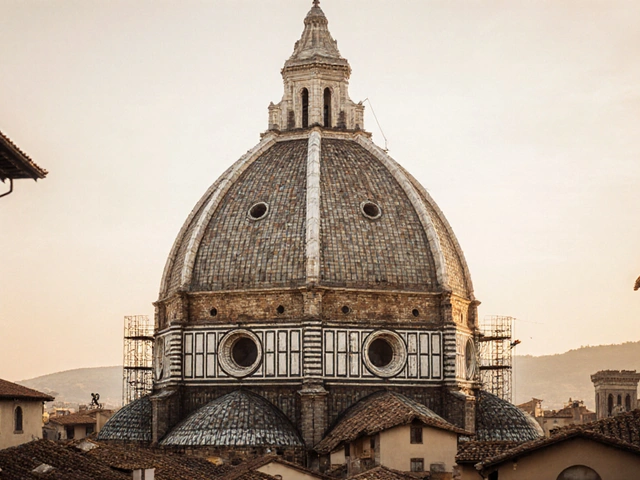Sweeping vaults, domed cathedrals, and elegant courtyards didn’t just appear from nowhere—the Renaissance was an explosion of creative energy that transformed the very bones of Europe’s cities. Imagine walking through Florence in the early 1400s. Every corner is buzzing with talk of ancient Rome, and every stonemason and painter is eager to ditch the old rules. “Why pointy and crowded?” they ask, staring at the shadowy spires of the old Gothic world. “Why not balanced, bright, and inviting?” The switch didn’t just create pretty buildings; it redefined what architecture could do, who it was for, and how it could show off the best parts of being human.
The Spirit of Change: What Sparked the Renaissance?
If you want to understand why the Renaissance happened, look at the bold thinkers crowding into Florence, Venice, and Rome. The Black Death had shaken Europe. Old social systems were crumbling. The rich didn’t want to just show off God’s glory. They wanted to show off their own. Money, ambition, and curiosity fueled a hunt for fresh ideas. Artists, mathematicians, and philosophers dusted off the works of the Greeks and Romans. Suddenly, buildings needed to be smart, not just big. Architects like Filippo Brunelleschi started measuring, sketching, and planning like engineers, not mere craftsmen.
One of the biggest game changers was linear perspective. This wasn’t just a trick for frescos—it made people think about space and depth, and it allowed architects to create buildings that felt logically connected, with every room and courtyard fitting into a neat, visible order. That’s why the layout of the Palazzo Medici or the dome of the Florence Cathedral still feels so organized. It’s not accidental. Everything was deliberate and rational. Texts like Vitruvius’s “Ten Books on Architecture” became guides. By 1436, Brunelleschi’s dome crowned Florence’s Santa Maria del Fiore without scaffolding—a feat that stunned travelers, builders, and rivals alike.
Florence’s success quickly rubbed off on the rest of Italy. In Milan, Donato Bramante played with geometry and clarity to shape churches and palaces. Other cities joined in the race, competing not just for the tallest or oldest towers, but for harmony and clarity. At the heart of it all was the belief: good architecture reflects both math and the messy, beautiful unpredictability of life.
Style Breakers: How Did Renaissance Design Look Different?
You don’t need a history degree to spot a Renaissance building. First, the pointed Gothic arches gave way to gentle semicircles. Instead of high, gloomy windows, you get sunlight flooding in from balanced, evenly spaced openings. Builders swapped out complicated stone spiderwebs for flat columns and sweeping domes, making spaces open and inviting. Look at the columns in Florence’s Ospedale degli Innocenti—so solid, so calm, you could almost mistake them for something ancient if not for the playful details peeking out.
Symmetry was everything. If a courtyard had five arches on one side, you could bet there would be five on each other side, too. This wasn’t an obsessive tic—it was about showing that human reason could create order out of chaos. There’s a cool trick they loved: using mathematical ratios to plan everything from door heights to wall thickness. That’s why the Villa Rotonda, designed by Andrea Palladio, still feels “just right.” Walk through it and you’ll notice how each room relates to the whole house in a tight, logical way.
And don’t forget the domes. Before the Renaissance, no one knew how to build massive domes without dangerous wooden frames. Thanks to experiments in engineering—like Brunelleschi’s double-shell approach—builders could suddenly crown churches with immense (and safe) domes, visible for miles. In Rome, Bramante’s design for St. Peter’s Basilica became the gold standard, copied across Europe. Even the tiny details mattered. Places like Venice’s Ca’ d’Oro used painted ceilings, sculpted fireplaces, and rare marble—proof that design was about showing off skill from grandest dome to smallest banister.
Painting and sculpture followed architecture’s lead. For the first time, artists were invited to decorate buildings with works that matched their surroundings. Stories from the Bible were framed by classical columns, archways guided your eyes toward frescoes overhead. You see that flow in structures like the Sistine Chapel, where Michelangelo’s ceiling feels like part of the architecture, not stuck on afterward.
Spotting the Icons: Key Buildings and Architects That Defined the Renaissance
The Renaissance wasn’t some faceless movement; it was driven by specific people eager to leave their mark. If you want to future-proof your next Italian vacation with some serious bragging rights, aim to spot at least a few of the big names and their masterpieces.
Renaissance architecture would be nowhere without Filippo Brunelleschi. His dome in Florence is the showstopper, built with over 4 million bricks and still the largest masonry dome ever. You might not know this, but the dome’s clever herringbone pattern holds it all together—he borrowed the idea after studying ancient Roman ruins. Down the street, the Palazzo Medici is a study in subtle prestige: three stories, each using a different kind of stone finish, topped with a cornice that manages to look both tough and elegantly simple.
Donato Bramante changed Rome forever. Take Santa Maria delle Grazie in Milan, now more famous for hosting Leonardo’s “Last Supper,” but it’s Bramante’s simple, clean geometry that actually makes the place feel so right. His Tempietto, tucked into a courtyard, packs a perfect circle into a tiny space with stunning precision. And who could skip Andrea Palladio? The man basically invented the modern villa style. His Villa Rotonda, just outside Vicenza, still sets the template for stately homes from London to Virginia. If you spot a white-columned mansion or a neat little rotunda, you’re seeing his fingerprints.
You can travel further south to see the twisting staircase at the Vatican’s Belvedere Courtyard, shaped by Bramante, or north to Venice, where Jacopo Sansovino’s Library of Saint Mark brings ancient Roman flair to the heart of a lagoon. Each of these buildings has its own secrets—hidden symbols, tricky acoustics, and design tweaks meant to show off a city’s wealth or an architect’s genius. Even the palaces and homes were filled with coded meanings, like the tiny animal carvings in Venetian facades.
It’s not just about the architects with top billing. Craftspeople, stonemasons, even mathematicians, all helped. Some projects—like the dome in Florence—took generations and sometimes more than one architect, including fathers handing the site over to their sons. Here’s a quick look at some breakthrough numbers:
| Building | Location | Lead Architect(s) | Year Completed | Known For |
|---|---|---|---|---|
| Florence Cathedral Dome | Florence | Filippo Brunelleschi | 1436 | Largest masonry dome |
| Villa Rotonda | Vicenza | Andrea Palladio | 1567 | Perfect symmetry and harmony |
| St. Peter’s Basilica | Rome | Bramante, Michelangelo | 1626 | World’s largest church |
| Tempietto | Rome | Donato Bramante | 1502 | Pilgrimage site, circular design |
| Palazzo Medici | Florence | Michelozzo | 1484 | Pioneering Renaissance palace |
The Renaissance Legacy: How These Designs Shaped Modern Life
Today, you might see echoes of the Renaissance as soon as you step outside your door, even if you’re living nowhere near Italy. Museum entrances with grand columns, courthouses with symmetrical facades, university libraries modeled after basilicas—lots of modern public spaces borrow straight from those 500-year-old ideas. The focus on proportion and clear layout never went out of style. When symmetry and balance feel right to you, that’s precisely what Renaissance thinkers wanted. They believed good design boosts human dignity.
Want to bring Renaissance flair to your own space? You don’t have to install a full marble staircase. Start with three small tips architects still use:
- Stick to balanced layouts. For every window or door, try to create a sense of “evenness,” avoiding crammed or chaotic spaces.
- Use arches or curved lines in furniture, mirrors, or doorways for that soft, harmonious vibe.
- Mix in rich textures—like velvets, metals, or detailed woodwork—for visual depth, but don’t overwhelm with too much at once.
Even the tech world owes Renaissance architects a debt. Take the “golden ratio” (about 1:1.618), used once for planning churches, now turns up in smartphone design and web layouts. Cities around the globe still borrow the Renaissance’s grid patterns and open plazas. Frankly, the entire notion of an architect as a creative visionary managing giant projects is a Renaissance invention. Before then? Most builders just followed instructions. The Renaissance taught them to lead, to innovate, to experiment.
Sure, you might not spot a new dome popping up in your neighborhood any time soon, but every time you walk into a clear-headed, inviting building, you’re brushing up against their legacy. That mix of logic, beauty, and boldness—they built it for us, whether we realize it or not.





